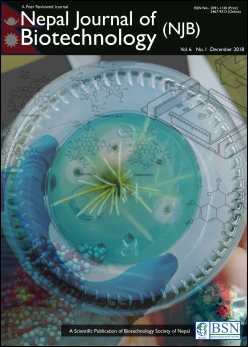Cyclospora cayetanensis: An Infestation among Diarrheal Children in Kathmandu Valley, Nepal
DOI:
https://doi.org/10.3126/njb.v6i1.22332Keywords:
Cyclospora, Parasites, Modified ZiehlNeelson, ChildrenAbstract
Cyclospora cayetanensis, a coccidian parasites which is responsible for recurring diarrhea and gastroenteritis especially among children living under poor hygienic condition in developing country like Nepal. Aimed of this research is to find out the prevalence of intestinal parasites and C. cayetanensis among diarrheal children in a Pediatric Hospital in Kathmandu valley, Nepal. Cross-sectional type of study was done. Altogether 196 stool specimens were collected from June to September 2013 among outpatient diarrheal children in Kanti Children’s Hospital. Modified Ziehl Neelson staining method was applied for detection of oocysts of Cyclospora after formal-ether sedimentation. Parasites were detected in 13.7% (27/196) of stool samples from ≤ 15 year old diarrheal patients. C. cayetanensis was detected in 4.8% (8/196). In genderwise, infection rate of C. cayetanensis 4.5 % (5/112), in male were higher than 3.6% (3/84) in female. In agewise, infection rate of C. cayetanensis in 5.7 % (3/52) 11-15 year old were highest followed by 4.1% (3/78) in 0-5 year old and 3.0% (2/66) in 6-10 year old. In seasonwise, infection rate of Cyclospora was highest in the month of August 7.4% (4/54) followed by 3.9% (2/51) in July, 2.3% (1/44) September and 2.1% (1/47) in June. Altogether five different type of parasites were detected. Infection rate of Giardia lamblia were highest 5.1 % (10/196) whereas lowest was Cryptosporidium parvum 1.0 % (2/196). Prevalence of C. cayetanensis is highly probable to infant, neonate, toddler and diarrheal children. Therefore, attention should be made in laboratory investigation of C. cayetanensis while suspecting the diarrheal patients infected with other parasites.
Downloads
Downloads
Published
How to Cite
Issue
Section
License
Copyright Notice:
The manuscript submitted to NJB must be an original contribution, not previously published and should not be under consideration for publication elsewhere. When the manuscript is accepted for publication, the authors agree to automatically transfer the copyright of the article to the publisher. It should grant permission to any third party, in advance and in perpetuity, the right to use, reproduce or disseminate your article, according to the NJB copyright and license agreement.
Authors transfer copyright to the publisher as part of a journal publishing agreement but have the rights to: Share their article for Personal Use, Internal Institutional Use and Scholarly Sharing purposes, with the NJB applies the Creative Commons Attribution-NonCommercial CC BY-NC license to all the works we publish after Jun 2020 (Before it was CC BY-NC-ND). Under this license, authors agree to make articles legally available for reuse, without permission or fees, for virtually any non-commercial purpose. Anyone may remix, adapt, and build upon your work non-commercially, and although their new works must also acknowledge you and be non-commercial, they don’t have to license their derivative works on the same terms. More details on CC BY-NC refer to its Licence Deed and Legal Code.






